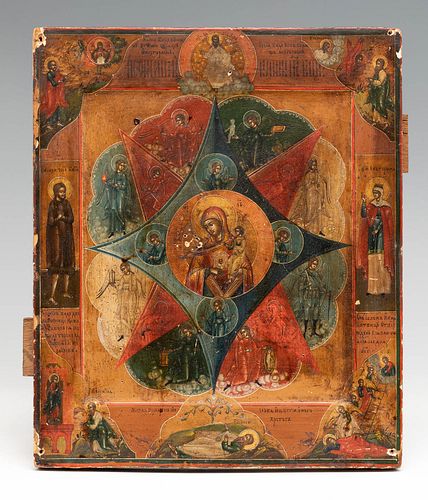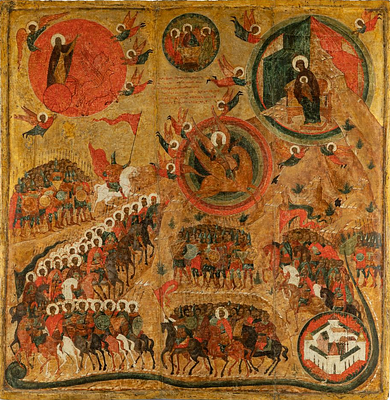Russian school, workshops of the Old Believers, first half of the 19th century. "The Virgin of Burning Bush. Tempera on panel.
Lot 30
About Seller
Setdart Auction House
Carrer Aragó 346
Barcelona
Spain
Setdart Subastas was born in 2004 and is currently the first online art auction in Spain with solidity, prestige and reliability guaranteed by our more than 60,000 users. Setdart has a young, dynamic and enterprising team ready to successfully manage the purchase and sale of art works through custom...Read more
Estimate:
EUR€1,500 - EUR€1,800
$1,562.50 - $1,875
Absentee vs Live bid
Two ways to bid:
- Leave a max absentee bid and the platform will bid on your behalf up to your maximum bid during the live auction.
- Bid live during the auction and your bids will be submitted real-time to the auctioneer.
Bid Increments
| Price | Bid Increment |
|---|---|
| EUR€0 | EUR€10 |
| EUR€200 | EUR€25 |
| EUR€500 | EUR€50 |
| EUR€1,000 | EUR€100 |
| EUR€3,000 | EUR€200 |
| EUR€5,000 | EUR€500 |
| EUR€10,000 | EUR€1,000 |
| EUR€20,000 | EUR€2,000 |
| EUR€50,000 | EUR€5,000 |
About Auction
By Setdart Auction House
Sep 23, 2021
Set Reminder
2021-09-23 10:00:00
2021-09-23 10:00:00
America/New_York
Bidsquare
Bidsquare : RUSSIAN ICONS
https://www.bidsquare.com/auctions/setdart-auction-house/russian-icons-7431
Setdart Auction House sofia@setdart.com
Setdart Auction House sofia@setdart.com
- Lot Description
Russian school, workshops of the Old Believers, first half of the 19th century. "The Virgin of Burning Bush. Tempera on panel. Measurements: 31 x 26 cm. The Virgin of the Burning Bush is one of the most complex and symbolic icons of the Marian theme in orthodox iconography. It alludes to the passage of the same name from the Old Testament. On the symbolic level it develops different facets of Christian worship related to the appearance of Christ, based on the Old Testament stories. This Old Testament Epiphany was commemorated by the creation of a chapel in honour of the Burning Bush, which was built behind the altar of the Cathedral of St Catherine's Monastery at the foot of Mount Sinai. The iconography is known from proto-Christian times, when the Praying Virgin, or in some cases the Odigidria, was depicted enclosed in the Burning Bush, with Moses kneeling and contemplating her. In the mid-16th century, coinciding with the rule of Ivan the Terrible, the icon of the Virgin of the Burning Bush changed its appearance and was enriched with symbols and allegories. At that time Old Russia was undergoing a major expansion of its territory towards Siberia, Astrakhan and Kazan. Russia has become the most important Orthodox centre in the world. The Virgin and the Burning Bush came to be depicted half-length, holding the Child Jesus in her arms, within a two-coloured eight-pointed star, which is composed of two rectangles, red, symbolising the Burning Bush, and green, which in some cases can be emerald-green, as in the case of the icon at auction, symbolising the growing bush. In the corners of the green rectangle we find the angels, protectors of the Virgin, and on the green clouds rest the elements of nature. In the corners of the red rectangle are the tetramorphs, and in the red clouds are the corresponding evangelists. In the corners of the icon rest four independent miniatures, alluding to different prophets, which in turn enrich and complete the Epiphany. Variations can be found. In the case of the icon of interest, these are Moses in the upper left corner, the prophet Isaiah in the upper right corner, Ezekiel in the lower right corner, and finally Jacob's ladder in the lower left corner. On the four sides of the icon is Jesse with the tree, on the lower side, on the left and right, Alexius of Constantinople and Saint Catherine respectively. The composition is crowned by the representation of God the Father. In turn, the abundant inscriptions in the spaces between the scenes accompany the visual iconography, explaining each scene. This interest in explaining biblical scenes by means of inscriptions developed in Moscow around the middle of the 16th century in intellectual ecclesiastical circles and became very popular in the iconography of the Old Believers. Other symbols that indicate that this icon belongs to the workshops of the Old Believers are the blessing with two fingers and the inscription of the name of Jesus Christ in the form of the abbreviation "IC XC".
- Shipping Info
-
In-house shipping available. Please inquire at admin@setdart.com.
-
- Buyer's Premium



 EUR
EUR CAD
CAD AUD
AUD GBP
GBP MXN
MXN HKD
HKD CNY
CNY MYR
MYR SEK
SEK SGD
SGD CHF
CHF THB
THB















